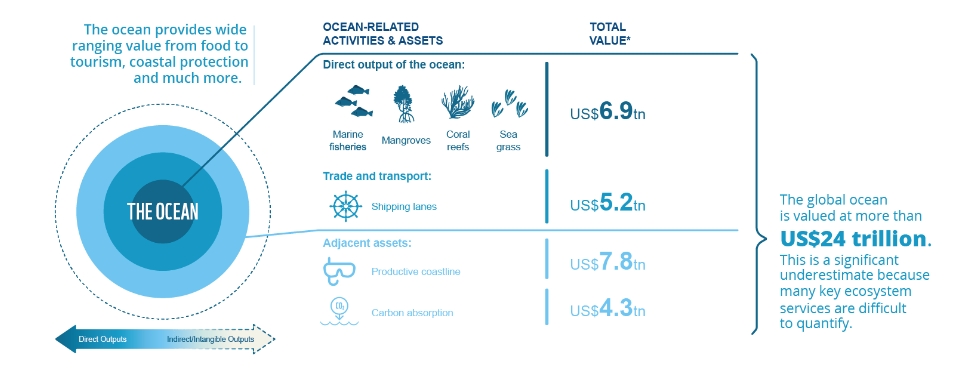INCLUSIVE SUSTAINABLE
BLUE ECONOMY
Opportunities to build resilient coastal communities
INCLUSIVE SUSTAINABLE
BLUE ECONOMY
Opportunities to build resilient coastal communities

AN OCEAN INCUBATOR FOR COASTAL COMMUNITIES
Without a healthy ocean, our future prosperity – indeed, life on Earth as we know it – is in
jeopardy. The need for a change in our relationship with the marine environment has started to break through. Leaders from outside the environment sector are calling for better protection and management of this vital shared asset. Failure to act means further squandering our assets, and running down the economic engine that supports countless people worldwide. If the response to conservationists’ pleas about the plight of our ocean assets has been, “So what?” then here is the US$24 trillion answer.

This report is available here.
The sustainable blue economy is estimated to be worth $24 trillion, and as investors and policymakers increasingly turn to the ocean for new opportunities, this economy has been forecasted to double in size by 2030 (OECD 2016). However, the loss of natural capital resulting from unsustainable activities continues to erode the resource base on which such development depends. We need to ensure that a healthy ocean is at the centre of our collective ambitions – including government, civil society and the private sector – to ensure that economic activities in our seas are sustainable and that society’s needs are met.
The concept of a blue economy is recognized as central for sustainable development. However, much of the emphasis to date has been placed on short-term economic gains. As a result, traditional livelihoods and small-scale local operations are frequently outcompeted by business-as-usual activities with little regard for social inclusion and environmental sustainability.
The most fundamental principle of a sustainable blue economy, often overlooked in the interest of these short-term economic gains, is that nature and people are at its centre. Bringing communities into the centre of global, regional and local efforts is key to the successful delivery of a sustainable blue economy. Many coastal areas are under the stewardship of communities that are struggling with food security, viable livelihoods, health, education and safety.
The principles for inclusive
sustainable blue economy

EQUITY

INCLUSIVITY

GENDER

SCALE IS BY FAR THE CHALLENGE
It is also important to bear in mind that investment itself is not the only barrier for the advancement of a sustainable blue economy at the local scale.
This Portfolio
will address
these barriers
Sources of investment are available for commercially viable sustainable blue economy activities, notably alternative or improved livelihoods. But coastal communities are often unable to access these sources of finance.
Common barriers to investment include:
- Underdeveloped business models – sustainable livelihoods activities are often at an early stage of business development, and their commercial viability is therefore less certain.
- Sub-scale investments – sustainable livelihoods activities are typically operated at a community level, and are sub-scale for commercial investment.
- Low/slow growth return profiles – sustainable livelihoods activities typically generate lower, longer-term return profiles than commercial investment activities.
Addressing these and other barriers is critical to enabling investment in highly beneficial and impactful sustainable blue economy activities.
REVENUE AND FINANCE
FINANCE is a tool that can
be used to bridge the time
gap in project funding
needs.
PROJECT CASHFLOWS suitable for raising finance can
be generated primarily through:
– Cost-saving shared from a financial beneficiary.
– Capital gain achieved on the appreciation of an asset.

Most policy discussions will highlight the importance of unlocking private and public sector finance for the sustainable development of coastal communities. The creation of large scale community-led initiatives and enterprises that offer viable financial returns must be prioritized.
While there is a mushrooming of blue accelerators and impact investment funds focused on delivering a sustainable oceans economy, the focus must now shift from high growth sectors to the challenge of building the resilience of coastal communities.
THERE ARE TWO TYPES OF PROJECTS THAT THE SUSTAINABLE DEVELOPMENT COMMUNITY MIGHT PRESENT TO THE PRIVATE SECTOR AND/OR INSTITUTIONAL DONORS:

COASTAL COMMUNITIES WILL ALSO NEED SUPPORT TO:




